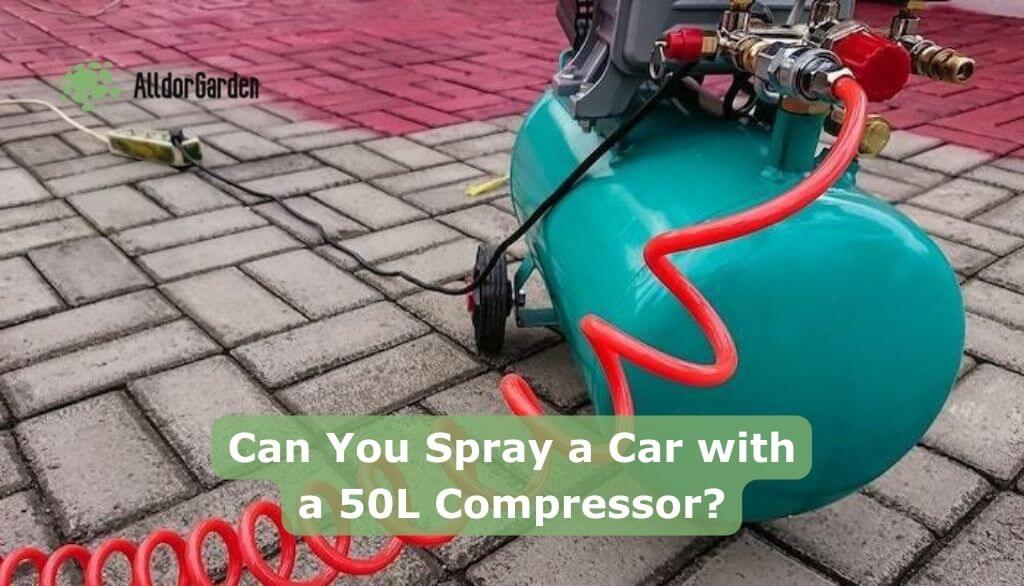When it comes to painting cars, DIY enthusiasts and professional painters alike are often limited by the tools they have at their disposal. One crucial piece of equipment in the car painting process is an air compressor. The size of the air compressor is a determining factor in its ability to support the painting process.
In this blog post, we’ll explore whether a 50-liter compressor is capable of spraying a car, the challenges associated with it, and tips for getting the best results.

What Is an Air Compressor?
An air compressor is a device that converts power into potential energy stored in pressurized air. This pressurized air is then used to power various tools, including paint sprayers. Air compressors come in various sizes, measured in liters, gallons, or cubic feet. The bigger the compressor, the more air it can store, and the more powerful it can be.
Can You Spray a Car with a 50L Compressor?
Yes. Spraying a car with a 50L compressor is possible, but it depends on the air requirements of the spray gun being used. A 50L air compressor is not really big enough. Most spray guns require a minimum of 4-8 CFM of air supply to operate effectively. Therefore, it is important to check the manufacturer’s specifications for the spray gun being used and ensure that the compressor can deliver the required air supply.
For automotive painting, a compressor with a minimum of 10 CFM and 30-40 PSI is recommended. While a 50L compressor may be sufficient for smaller paint jobs or touch-ups, it may struggle to maintain consistent air supply for larger projects. The main reason is that a smaller compressor may struggle to maintain the required air pressure for an extended period, resulting in an uneven paint job or frequent stops to allow the compressor to catch up. In such cases, a larger compressor with a higher CFM rating may be necessary to ensure optimal results.
Challenges with a 50L Compressor
- Maintaining consistent air pressure: A smaller air compressor may struggle to maintain a consistent air pressure, which is essential for a uniform paint job. As a result, you may experience fluctuations in the spray pattern, leading to an uneven finish on your car.
- Limited working time: With a smaller compressor, you may need to stop frequently to allow the compressor to recharge. This can be frustrating, especially if you’re in the middle of painting a large panel or working on a detailed section.
- Overheating: Smaller compressors can overheat when used for extended periods, potentially causing damage to the compressor or even posing a safety risk.
Tips for Spraying a Car with a 50L Compressor
Despite the challenges, it is possible to achieve a decent paint job with a 50L compressor. Here are some tips to help you get the best results:
- Ensure proper ventilation: Make sure you’re working in a well-ventilated area to prevent the buildup of paint fumes, which can be hazardous to your health.
- Choose the right paint gun: Use a high-volume, low-pressure (HVLP) spray gun, which requires less air pressure to operate and is more efficient with smaller compressors.
- Work in smaller sections: Break the car into smaller panels or sections, and work on one section at a time. This will give the compressor time to recharge between sections and help you avoid an uneven finish.
- Monitor the compressor: Keep an eye on the compressor’s pressure gauge and temperature to avoid overheating and maintain consistent air pressure.
- Practice patience: Allow the compressor to fully recharge between sessions, and be prepared for the painting process to take longer than it would with a larger compressor.
How Big a Compressor Do You Need for Spray Painting?
FAQs
What Size Compressor Do I Need to Spray a Car?
What Is the Air Requirement of a Typical Spray Gun?
How Much Air Compressor Do I Need to Paint a Car?
What Can I Use a 50L Air Compressor For?
How Long Does a 50L Compressor Take To Fill?
Conclusion
While spraying a car with a 50L compressor is possible, it is not ideal. The process will likely require more time, patience, and attention to detail than using a larger compressor.
If you’re serious about painting your car, it may be worth investing in a larger compressor or hiring a professional to ensure a high-quality result.




